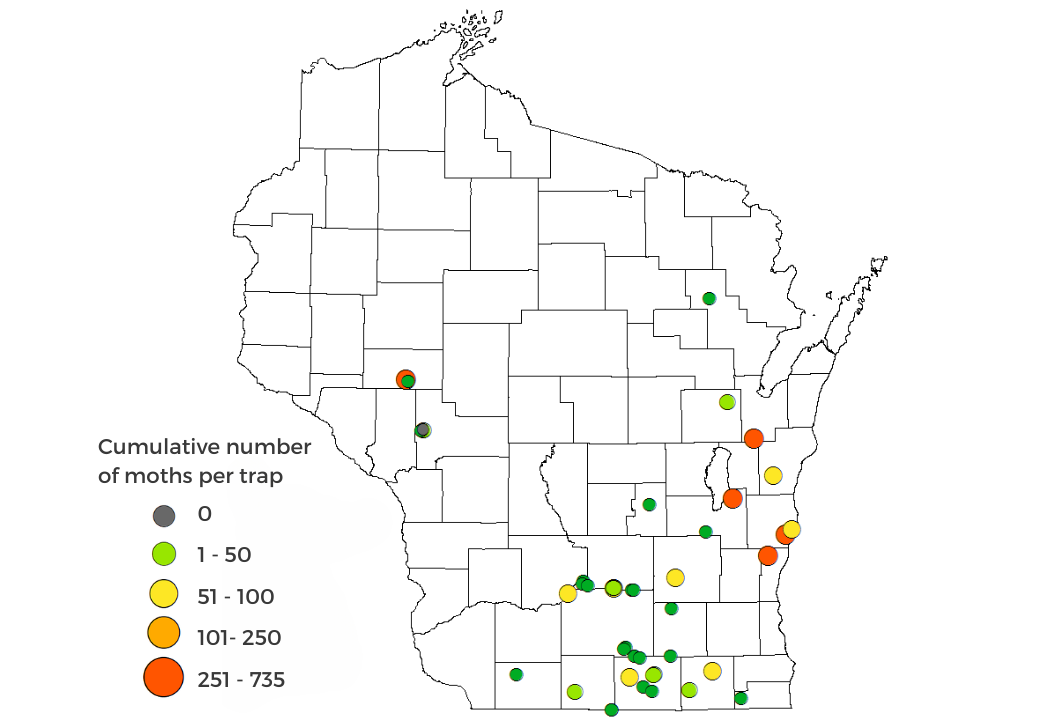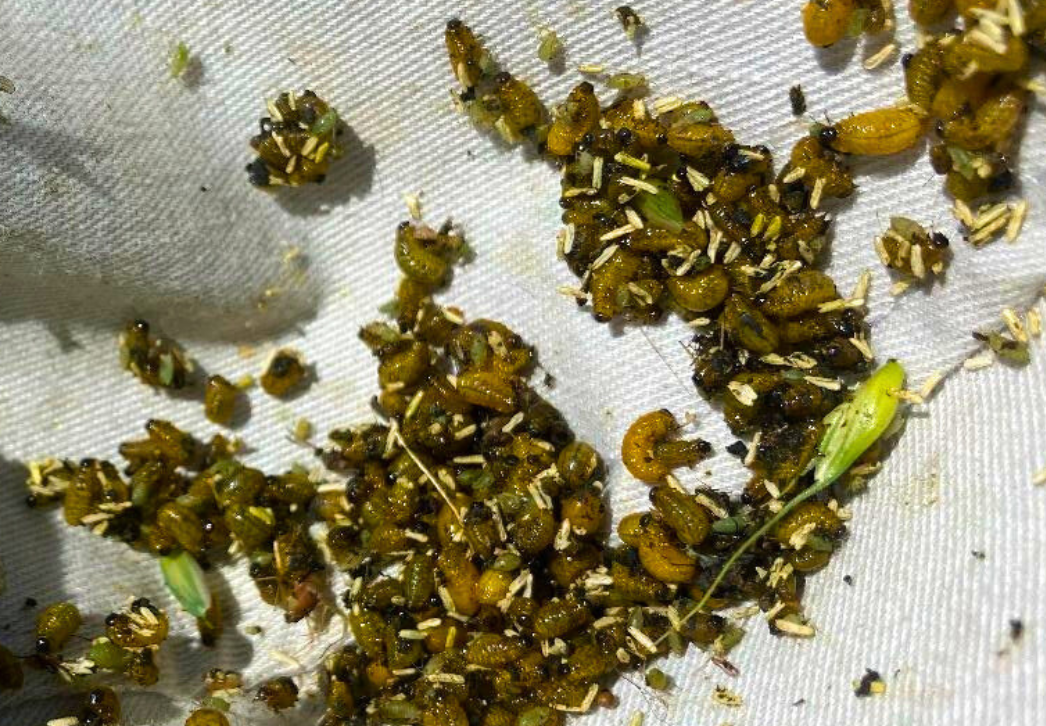|
|
Another week of unsettled weather across the state featured several days of light showers and locally severe thunderstorms. Heavy rain diminished as compared to the previous week, with lower precipitation totals ranging from 0.2 to 1.0 inch during the seven-day period ending June 13. Highest daytime temperatures reached the middle 80s and nighttime lows ranged from the upper 30s to around 60°F.
While planting of corn, soybeans, and other summer crops should be winding down, the every-other-day rainfall is impeding late planting efforts. Much of northern Wisconsin has reportedly struggled with excessive wetness and drier conditions are needed for both planting completion and timely weed management. According to the June 10 USDA NASS Crop Report for Wisconsin, corn planting advanced only three points from the preceding week, and the level of completion (87%) continued to trail the 5-year average pace (93%). The first cutting of alfalfa hay is currently about 61% complete, six days behind last year and one day behind average.
__________________________________
|
|
|
DATCP surveys in wheat fields from Dane County northeast to Calumet County indicate that true armyworm larvae are active in scattered fields, although the counts recorded to date have been well below economically significant levels. Numbers of armyworm caterpillars collected at sites in Brown, Calumet, Dane, Dodge, and Fond du Lac counties ranged from 1-6 per 100 sweeps and averaged only one larva per 100 sweeps. Larvae in eastern Wisconsin were approximately one inch-long and in the third or fourth instars as of June 13.
While the counts noted during recent wheat surveys are not concerning, now is the time of year when first-generation armyworms are reaching the last instar stage of development when most feeding occurs. Severe damage to corn and small grains can appear seemingly overnight, therefore routine scouting and early detection of emerging problems will be especially important through the end of the month.
As shown in the map below and on the DATCP true armyworm network page, the highest cumulative trap counts of the season have been reported from the east-central region, in Brown, Fond du Lac, Ozaukee, and Sheboygan counties. One Eau Claire County site in the west also recorded a cumulative capture above 250 moths. Recall that high pheromone trap counts do not reliably foreshadow field infestations and a definitive moth capture threshold does not exist for true armyworm. In short, it is impossible to know if or where infestations will develop based on trap counts. Scouting fields is the only decisive way to determine armyworm presence and localized risk of outbreaks.
   Any decision to treat armyworms should be based on the percentage of plants in a field with feeding damage, the number of larvae present, and the size of the larvae. Treatment efficacy is greater when the larvae are <1.0 inch long.
- For corn fields, UW-Extension recommends sampling five sets of 20 plants (100 total). Spot treatment is acceptable for infestations of two or more armyworms (0.75 to 1.0 inch or smaller) per plant on 25% of the corn plants, or one worm per plant on 75% of the corn plants.
- In wheat and small grains fields, scouting requires checking the soil surface between two rows at several points in the field to determine the number of armyworms per square foot. Treating small grains is justifiable for levels of three or more armyworms per square foot.
|
|
 __________________________________
|
|
Emergence of the destructive Japanese beetle has started unusually early this season. A resident near Cross Plains in Dane County photographed a beetle on June 2, according to a report from UW-Madison Entomologist PJ Liesch. The early appearance of this pest has likely been influenced by this spring’s warmer and wetter-than-normal conditions and signals for fruit growers and gardeners to begin making preparations to protect sensitive trees and garden plants from beetle feeding. Beetle populations will continue to increase in the next two months, with peak activity occurring by late July. During the primary emergence and damage period ahead, residents can expect to see beetles consuming a wide range of landscape ornamentals, field crops, fruits, vegetables, and trees. Favored hosts include basil, birch, grape, linden, mountain ash, plum, and rose.
One of the most effective deterrents used by fruit and vegetable growers in DATCP’s pest monitoring networks is simple barrier netting (0.25 inch or less mesh). The nylon mesh netting can protect smaller plants such as berries, vegetables, herbs, shrubs, and young trees, as long as it fully covers plants and the edge of the mesh is secured to the ground. Netting should be in place by late June and maintained though harvest or until beetle populations decline in August.
Additional control options for Japanese beetles on landscape and garden plants are available by clicking the button below. The UW Fruit Program offers the following resource for apple growers: Managing Japanese Beetle in Apple | Wisconsin Fruit. |
|
 __________________________________
|
|
|
Surveys conducted in wheat fields across the southern and east-central areas of the state in the past week found mostly low insect counts, with a few exceptions. DATCP specialists sampled 32 fields in Brown, Calumet, Dane, Dodge, and Fond du Lac counties. In each field, sweep net samples for cereal leaf beetle, aphids, and true armyworm larvae were made at four sites (25 sweeps per site, 100 sweeps total per field).
Cereal leaf beetle larvae were collected from 16 of the fields sampled, true armyworm larvae were found in low numbers in seven of the fields, and aphids (including bird cherry oat aphid and English grain aphid) were common at low to moderate levels in the majority of the fields (26 out of 32). Overall, insect counts were below economic levels and damage was not apparent.
An exceptional Dodge County site had a very high cereal leaf beetle count of 400 larvae per 100 sweeps and the surveyor estimated 80% of plants in the field were showing defoliation and flag leaf feeding. Cereal leaf beetle populations that reach or exceed one larva per flag leaf when grain is heading may qualify for treatment.

|
|
Cereal leaf beetle larvae June 10, 2024 | S. Anhalt DATCP |
|
Based on the larval instars collected June 7-13, the peak feeding period may have occurred by now in southern and eastern Wisconsin and chemical control would not be advantageous for most fully headed wheat fields. The larval stage for cereal leaf beetle is brief and requires only about 10 days to complete, making the optimal chemical control window very narrow. |
|
 __________________________________
|
|
|
|
|